Super Bowl Stats
Millions of sports fans worldwide gear up each year for the Super Bowl, one of sports’ most eagerly awaited spectacles. This event features show-stopping plays and star-studded halftime performances, showcasing the best in athleticism, innovation, and showmanship.
Since its inception, the Super Bowl has gone beyond the realm of athletics to become a spectacle that seamlessly blends entertainment, sports, and business. It’s a celebration of the pinnacle of American culture and football that reaches viewers around the world. It has evolved into a beloved institution that resonates far beyond the world of athletics, serving as an annual celebration that unifies diverse people through their shared love of the game.</p.
This thorough statistical analysis delves deeply into the Super Bowl, offering an intricate exploration of its rich history, substantial economic influence, and widespread cultural importance.
Table of Contents
Key takeaways
- 1967 saw the debut of the Super Bowl.
- The highest total ever scored in a Super Bowl was 75 points.
- Five MVP awards have been handed to a single player.
- Quarterbacks make $5.8 million on average each year.
- The largest crowd to ever watch a Super Bowl live was 103,985.
- 7 million people streamed Super Bowl LVII, setting a new record.
- In the US, shoppers are predicted to spend $16.5 billion on items related to the Super Bowl.
- On Super Bowl Sunday, the expected consumption of chicken wings in the United States is 1.25 billion.
- For Super Bowl LVII, a 30-second commercial cost an average of $7 million.
- Eleven Super Bowls have been held in a single city.
- During Super Bowl LVII, Verizon’s cellular network was utilized by about 60% of spectators.
- The most valuable NFL team is worth $9 billion.
- 121.07 million people watched Rihanna’s halftime performance during Super Bowl LVII.
- During Super Bowl LVII, Apple Music saw over 320,000 engagements.
Super Bowl through the years?
Studying the historical development of the Super Bowl is essential because it offers valuable insights into the changing landscape of American sports culture. Looking back in time allows us to better understand the impressive growth and transformation of the NFL, which has firmly established itself as a dominant force in today’s sporting world.
- 1960: The year when the American Football League (AFL) emerged, seeking to challenge the established dominance of the National Football League (NFL). This rivalry played a crucial role in the creation of the iconic event we now know as the Super Bowl.
- 1966: This year, marked by a competitive bidding war for the talented placekicker Pete Gogolak, was a pivotal moment in the evolution of the Super Bowl.
- 1967: The year in which the first Super Bowl game was held. The event, formerly known as the AFL-NFL World Championship Game, took place on January 15, 1967, at the Los Angeles Memorial Coliseum in Los Angeles, California.
- 1970: This year left an indelible mark on the sports world, acting as the crucial turning point in the historic merger of the National Football League (NFL) and the American Football League (AFL), reshaping the landscape of professional football for good.
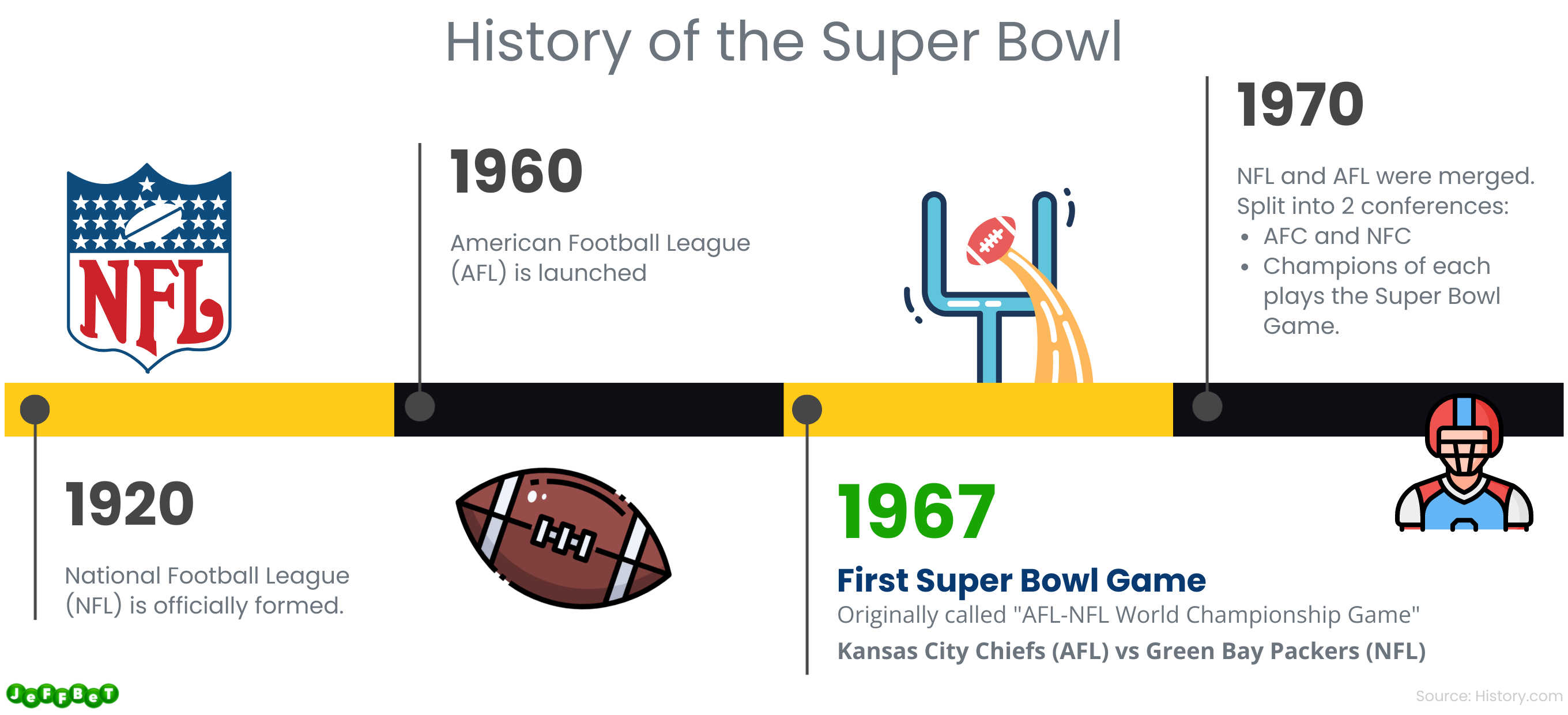
- 2023: The latest iteration of the Super Bowl (Super Bowl LVII) was played on February 12, 2023 at the State Farm Stadium in Glendale, Arizona.
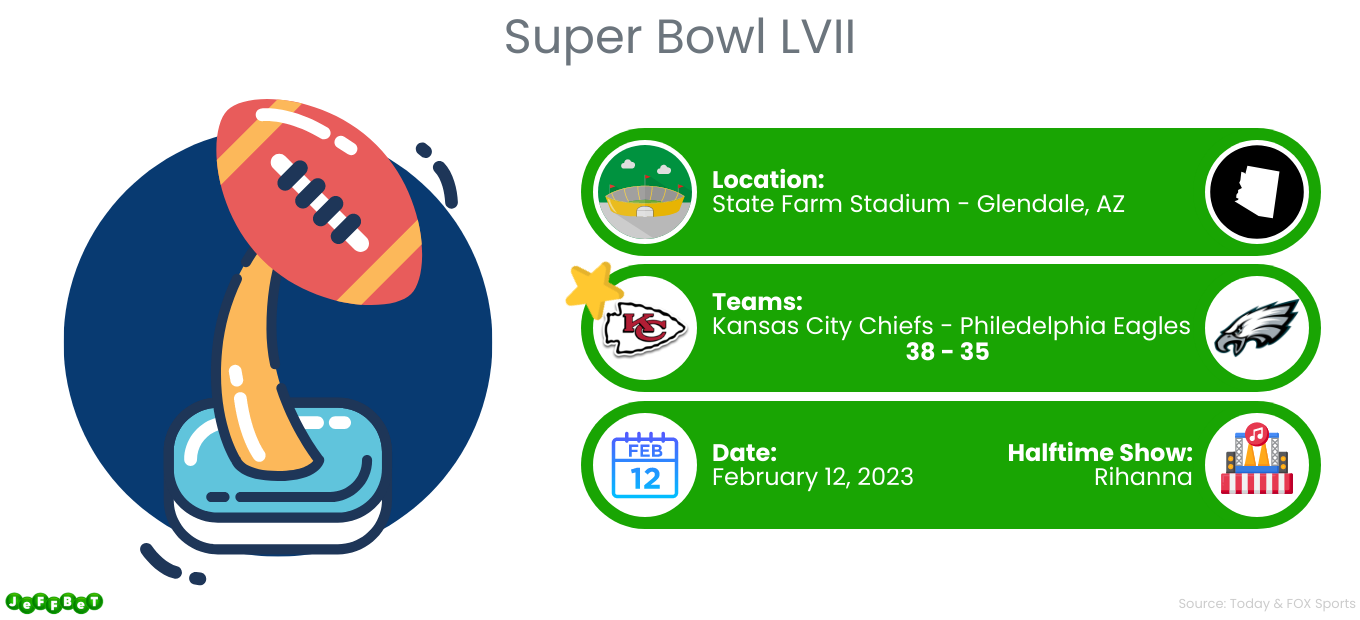
- 94,000: The number of seats offered in the Los Angeles Memorial Coliseum, which hosted the first Super Bowl in 1967.
- 61,000: The number of spectators at the inaugural Super Bowl. The poor attendance rate was caused by supporters thinking the tickets, with a top price of $12, were too expensive.
- 50 million: CBS and NBC, who had split the broadcasting rights to the game, both televised Super Bowl I at the same time. According to CBS and NBC, the average viewership was 26 million and 24 million, respectively.
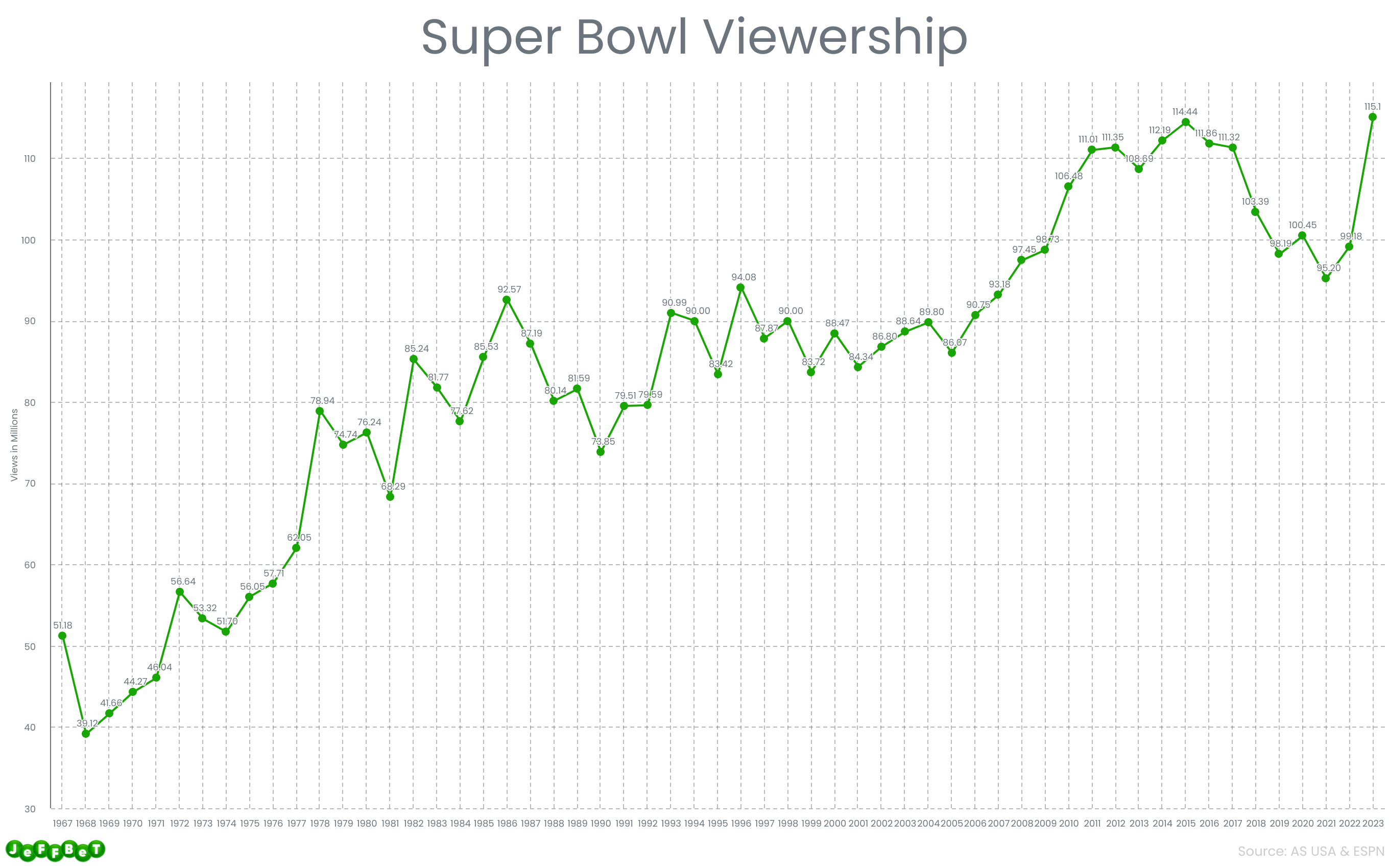
- 35-10: The final score of the Super Bowl’s inaugural championship game. The Green Bay Packers defeated the Kansas City Chiefs to claim the title.
- 57: The total number of Super Bowl games played to date.
- 67,827: The number of people who showed up for Super Bowl LVII. The 63,400-seat stadium that served as the game’s venue has the capacity to hold 73,000 people maximum.
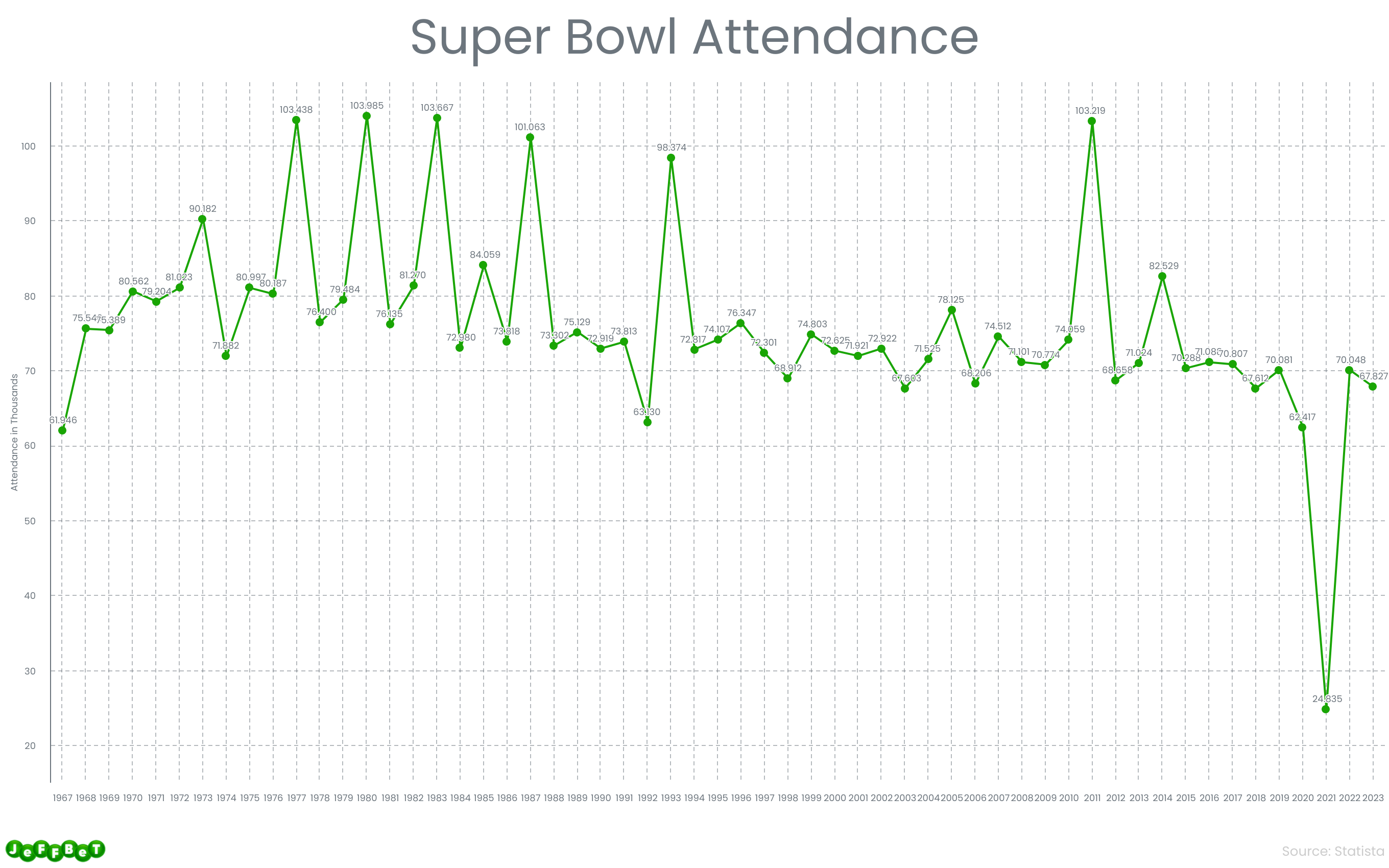
- 38-35: The final score of the most recent Super Bowl championship matchup. The Philadelphia Eagles were defeated by the Kansas City Chiefs to claim victory.
Super Bowl wins
Counting Super Bowl wins offers a straightforward way to measure the accomplishments and impact of NFL teams and the individual players who’ve made their mark in the sport. These victories provide concrete evidence of the dedication, teamwork, and overall excellence associated with American football. By tallying these wins, a clear pattern of sustained excellence in the highly competitive league becomes unmistakably apparent.
- 20 teams: The total number of teams who have won the Super Bowl in history. There are presently 32 NFL teams, which shows that 12 of them have never claimed a championship.
- 6 wins: The highest total number of victories a team has ever had. The teams with the most victories, six each, are the New England Patriots and the Pittsburgh Steelers.
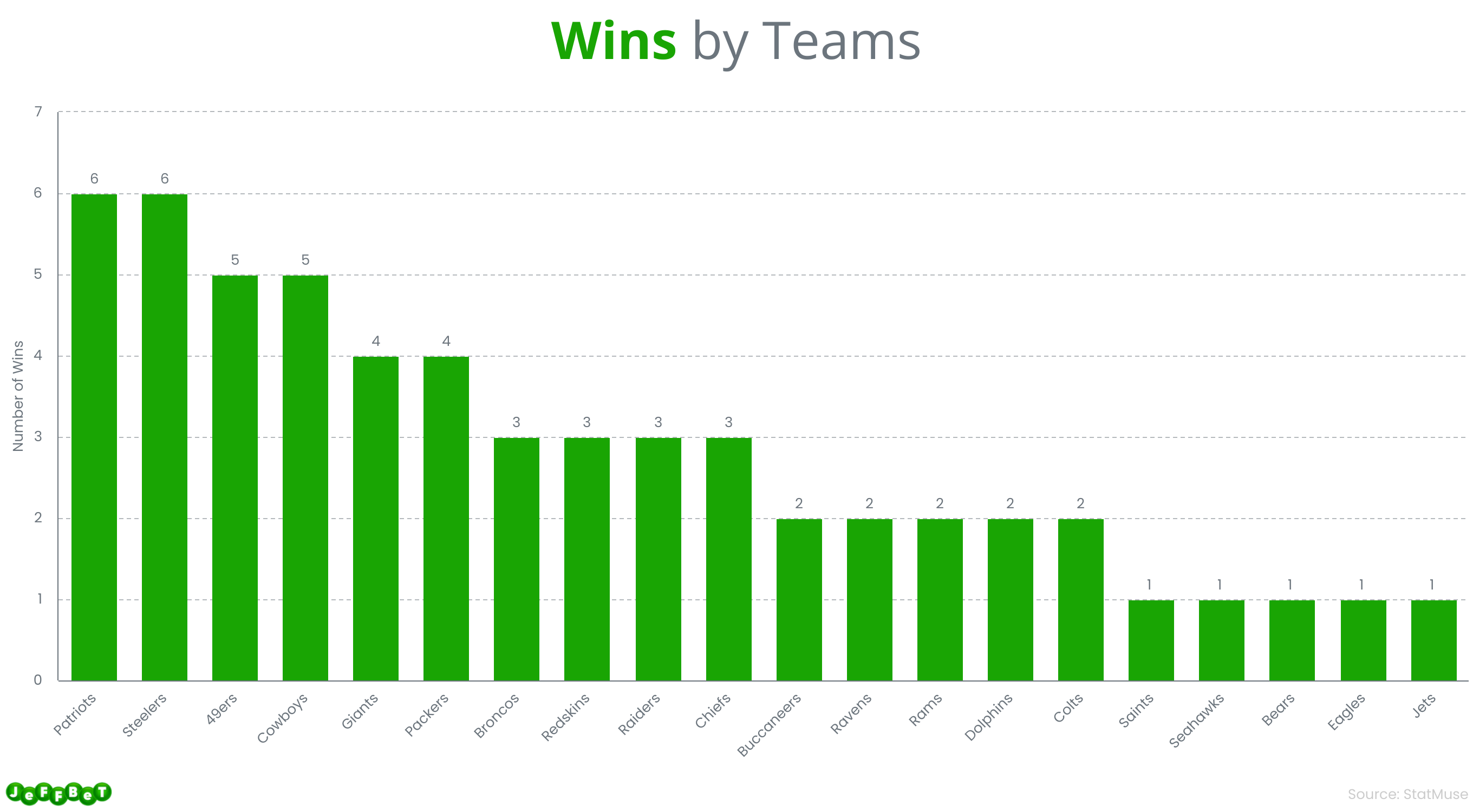
- 5 losses: The total amount of defeats a team has sustained. With five defeats each, the New England Patriots and Denver Broncos hold the record for the most Super Bowl losses.
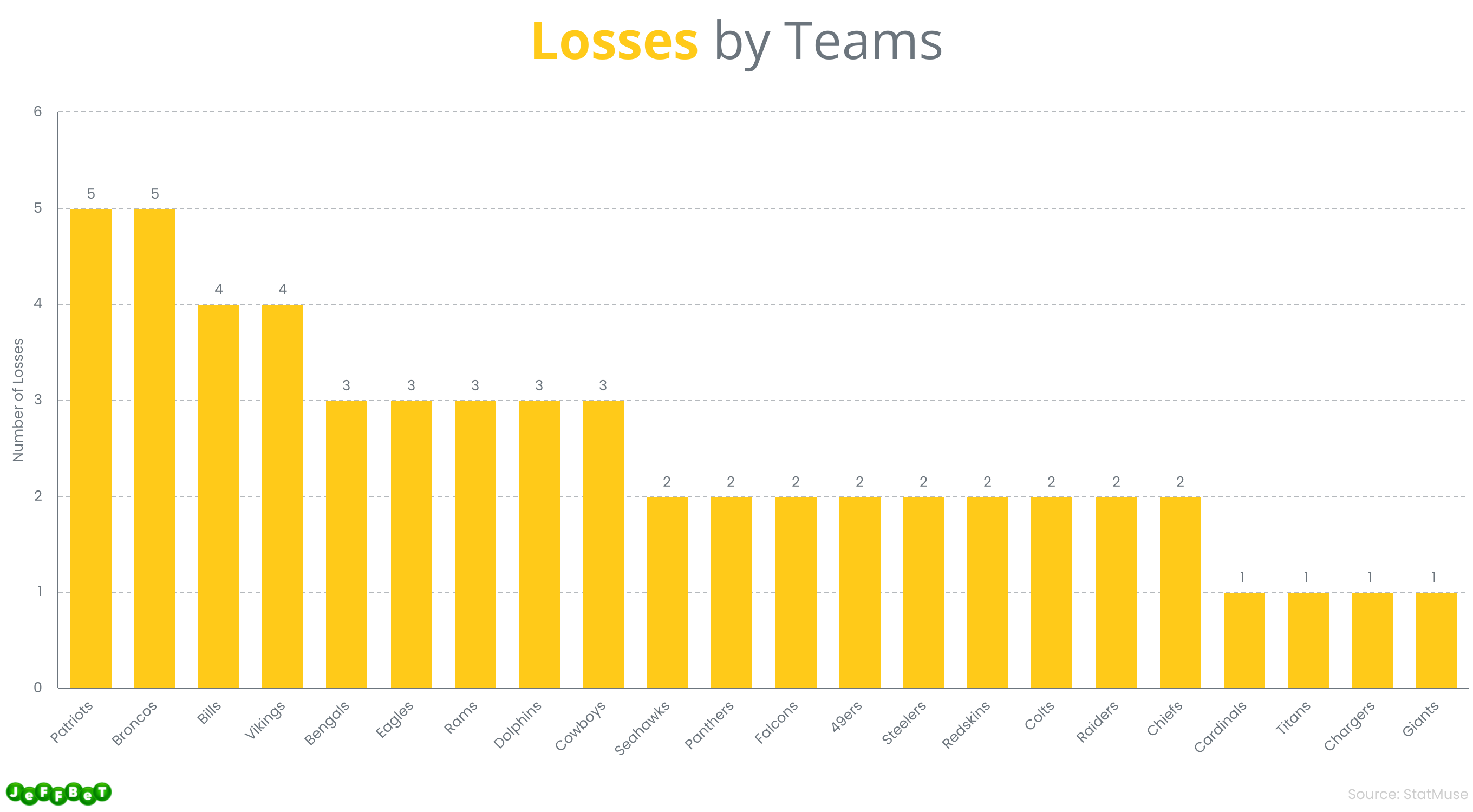
- 75 points: The highest score ever registered in Super Bowl history. This landmark was reached when the San Francisco 49ers defeated the San Diego Chargers 49–26 in Super Bowl XXIX on January 29, 1995.
- 16 points: The worst score ever registered in a Super Bowl. On February 3, 2019, the New England Patriots defeated the Los Angeles Rams 13-3 in the lowest-scoring Super Bowl in NFL history.
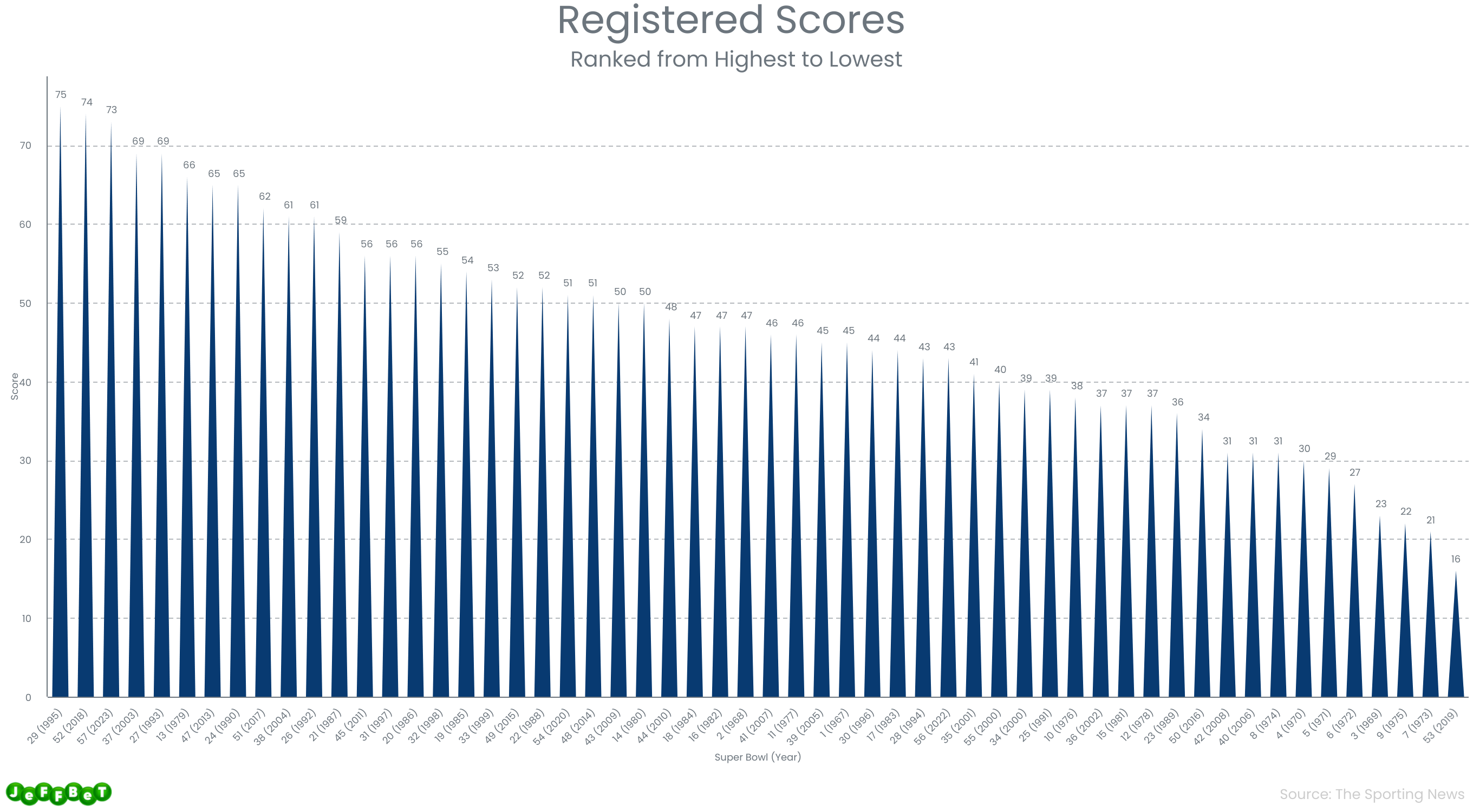
- 55 points: The highest total ever scored by a team in a Super Bowl. The San Francisco 49ers achieved this milestone on January 28, 1990, when they played the Broncos in Super Bowl XXIV.
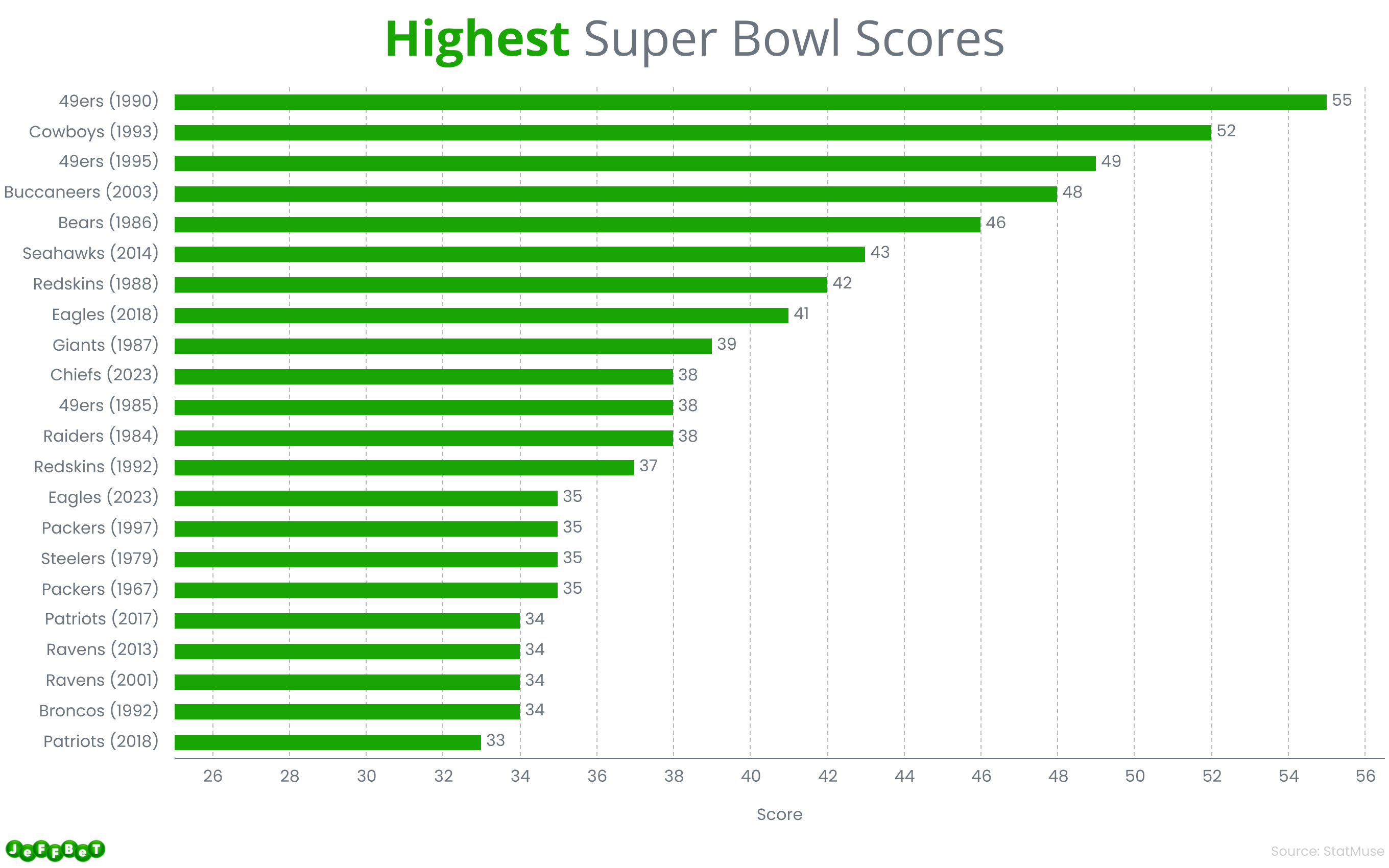
- 3 points: The least amount of points ever scored by a team in a Super Bowl. The Los Angeles Rams and the Miami Dolphins reached this milestone in 2019 and 1972, respectively.
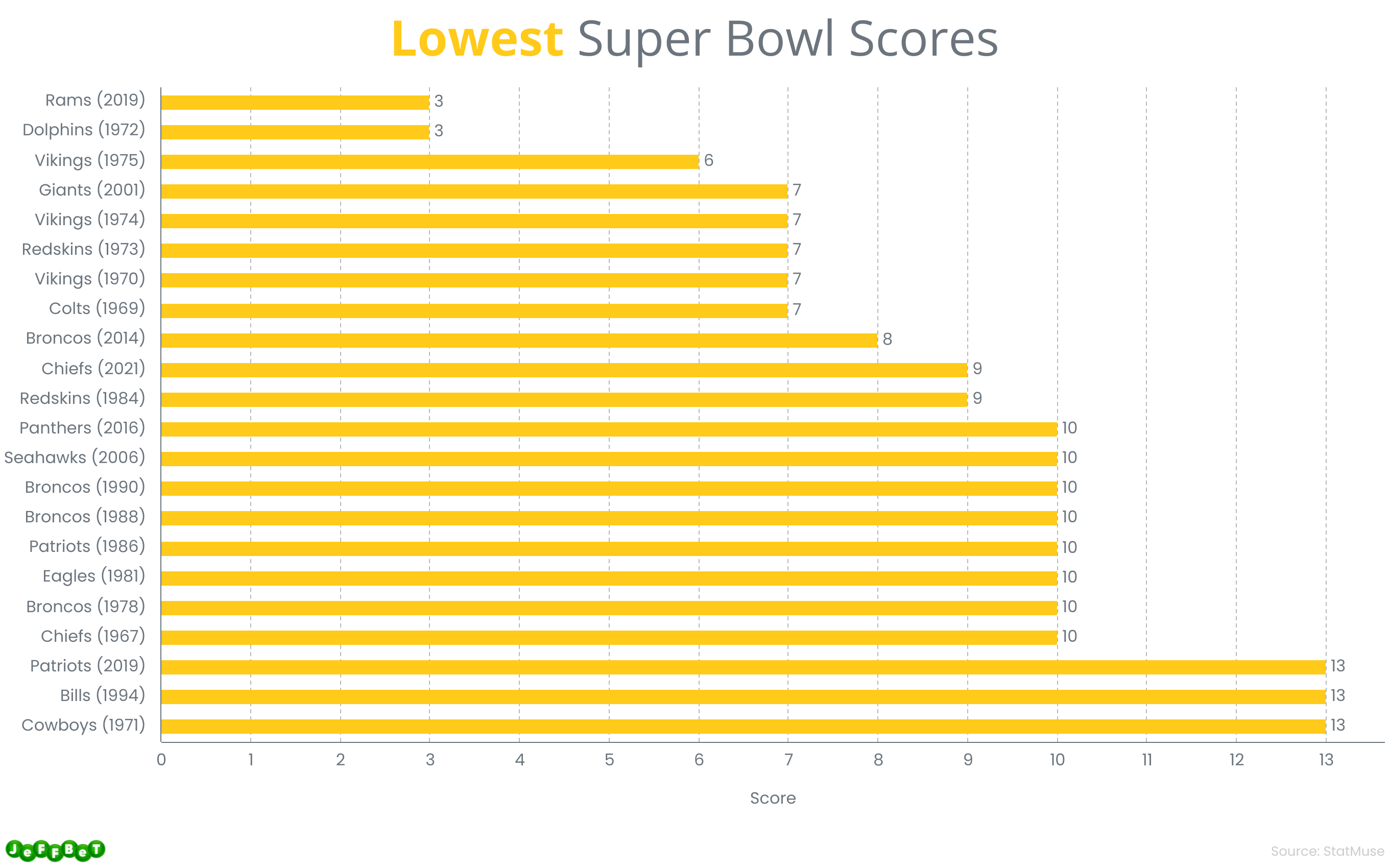
Super Bowl MVPs
Analyzing Super Bowl MVPs from a quantitative standpoint offers insight into a player’s influence during the game. It highlights their outstanding abilities, enabling fans to create a chronological record of their performance for meaningful comparisons.
- 1967: The year that the MVP award was presented for the first time. Bart Starr won the inaugural MVP award for a Super Bowl and continued to hold that title for the first two Super Bowls from 1967 to 1968.
- 5 titles: The most MVP honors awarded upon a single athlete. Tom Brady earns the distinction.
- 3 teams: The number of teams that have the most Super Bowl MVPs. The New England Patriots, Pittsburgh Steelers, and Dallas Cowboys receive this honor with six MVPs each.
- 89,214: The total number of passing yards Tom Brady has amassed in NFL history.
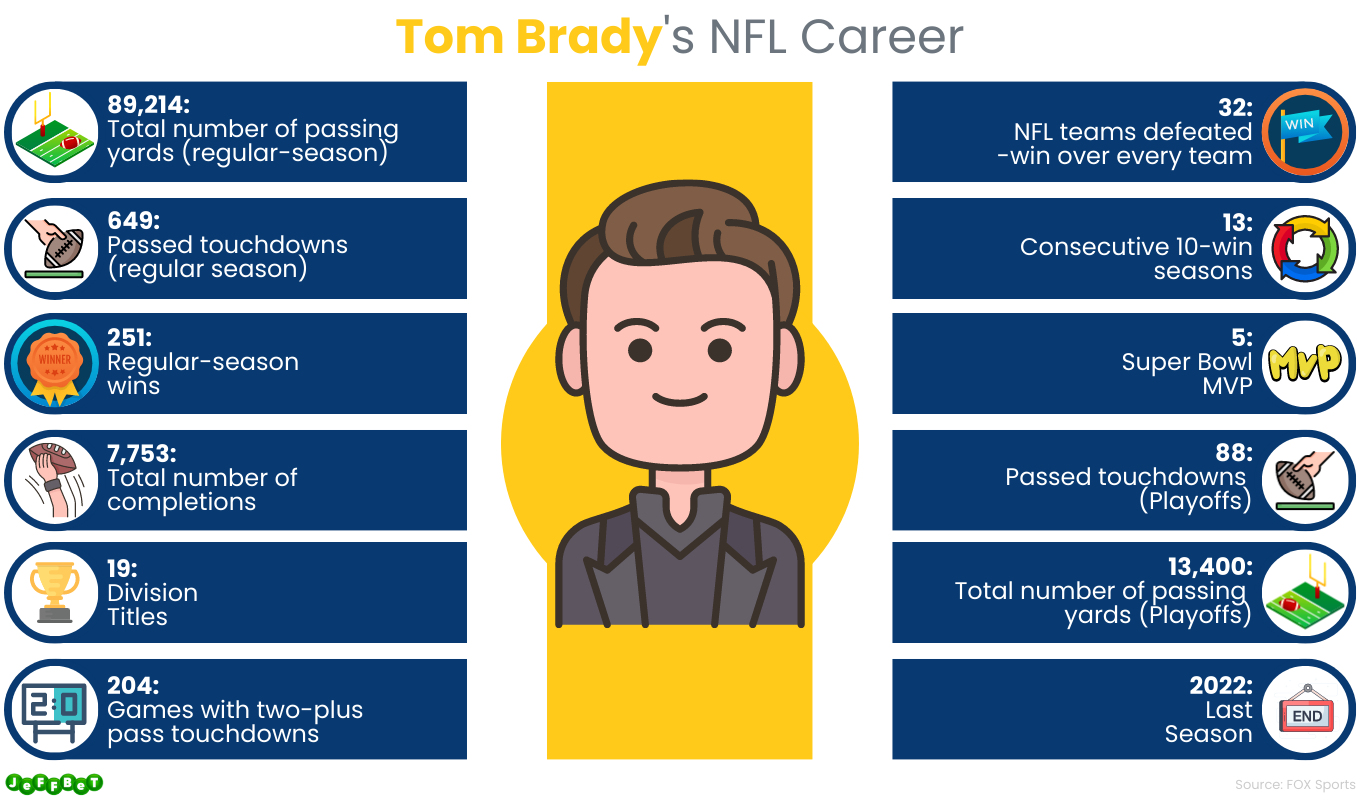
- 7 rings: The most number of titles or Super Bowl victories a player has earned throughout their career. Tom Brady, the most decorated player in NFL history, receives this distinction after winning his seventh championship in Super Bowl LV.
Player Salaries
Exploring NFL player salaries can help fans better grasp the financial aspects of their favorite teams and athletes. It also sheds light on the intricate economics behind professional sports, offering transparency. Additionally, it’s a way to gauge the league’s financial well-being and evaluate player talent, revealing how they’re valued based on skills, experience, and market appeal.
- $860,000: The median NFL player salary, excluding the highest earners.
- $5.8 million: The average quarterback wage per year. Top quarterbacks, though, can earn up to $25–$30 million annually. The highest-paid athletes include quarterbacks.
- $847,300: The median wage received by defensive ends.
- $630,000: The median pay for running backs. One of the lowest paid positions on the field.
- $332.96 million: The highest overall cumulative career earnings in the NFL. Tom Brady has reached this milestone throughout his NFL career, which he played from 2000 to 2022.
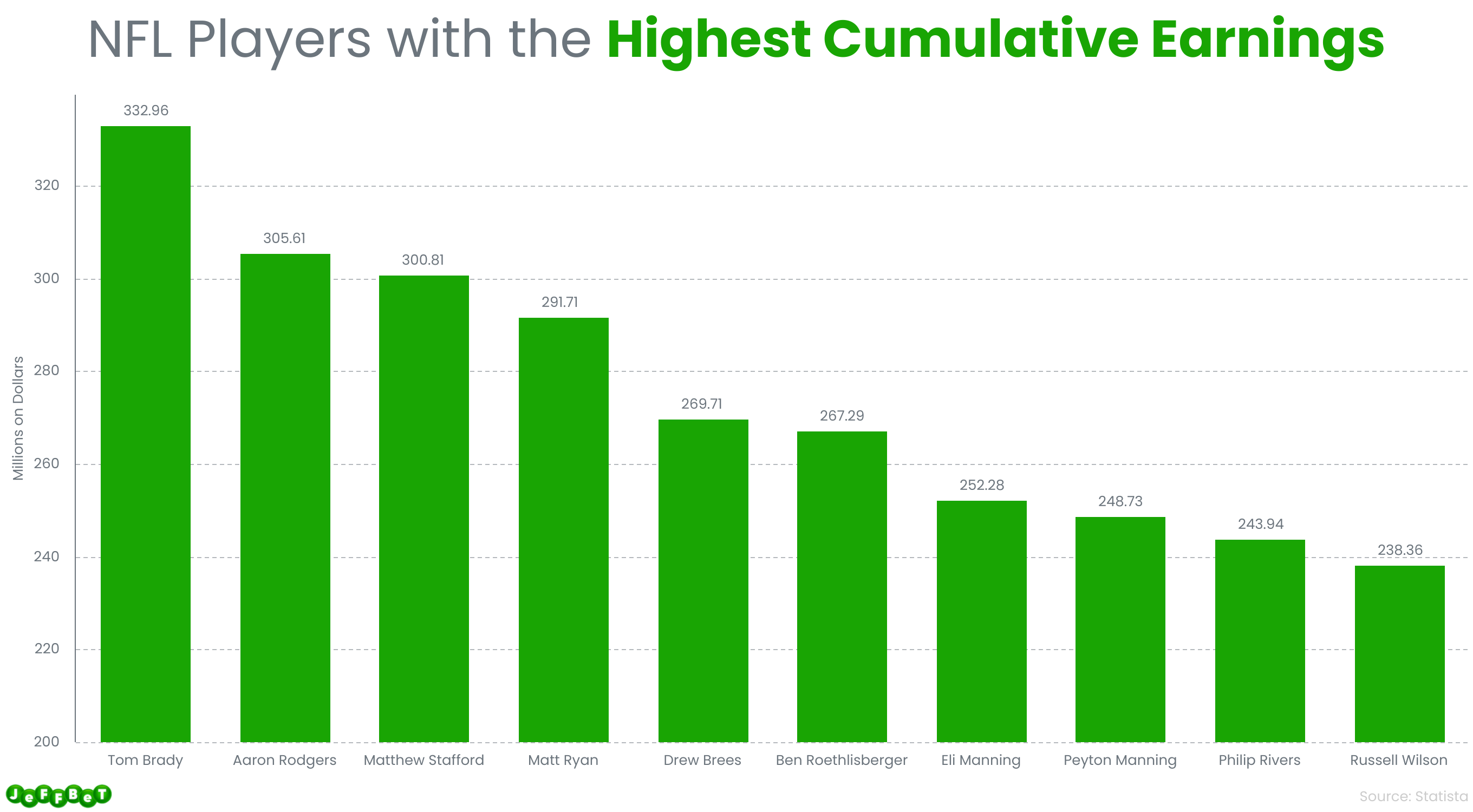
- $2.8 billion: The combined earnings of the 10 highest-paid NFL players, from Tom Brady to Russell Wilson, over the course of their careers.
Attendance Rate
Taking a closer look at the Super Bowl attendance rate provides insight into the game’s cultural significance and lasting appeal. It highlights the game’s profound impact, showcasing how it acts as a strong indicator of public interest and excitement for this monumental event. This reflects its ability to bring together and captivate a broad and diverse audience.
- 1980: The year with the most people in attendance for the Super Bowl live event. The Los Angeles Rams and the Pittsburgh Steelers played each other this year. The final result between the Steelers and Rams was 31-19.
- 2021: The Super Bowl year with the least amount of live event attendees. The Tampa Bay Buccaneers and Kansas City Chiefs played each other this year. The Buccaneers defeated the Chiefs by a score of 31-9.
- 103,985: The largest number of live event attendees in Super Bowl history. It took place on January 20, 1980 for the Super Bowl XIV, at the Rose Bowl in Pasadena, California.
- 24,835: The fewest spectators for a live event in Super Bowl history. It was held at the Raymond James Stadium in Tampa, Florida on February 7, 2021 for the Super Bowl LV.
- 67,827: The total number of live event attendees at the most recent Super Bowl championship. The event took place on February 12, 2023, at State Farm Stadium in Glendale, Arizona.
Viewership
Examining the historical viewership patterns of the Super Bowl since its inception can paint a clear picture of its impressive growth in recent times. This perspective offers valuable insights into the event’s deep significance, reaching well beyond the United States to make a global impact. It firmly establishes the Super Bowl as an iconic and internationally beloved spectacle.
- 193 million: The number of persons who intend to watch the Super Bowl this year.
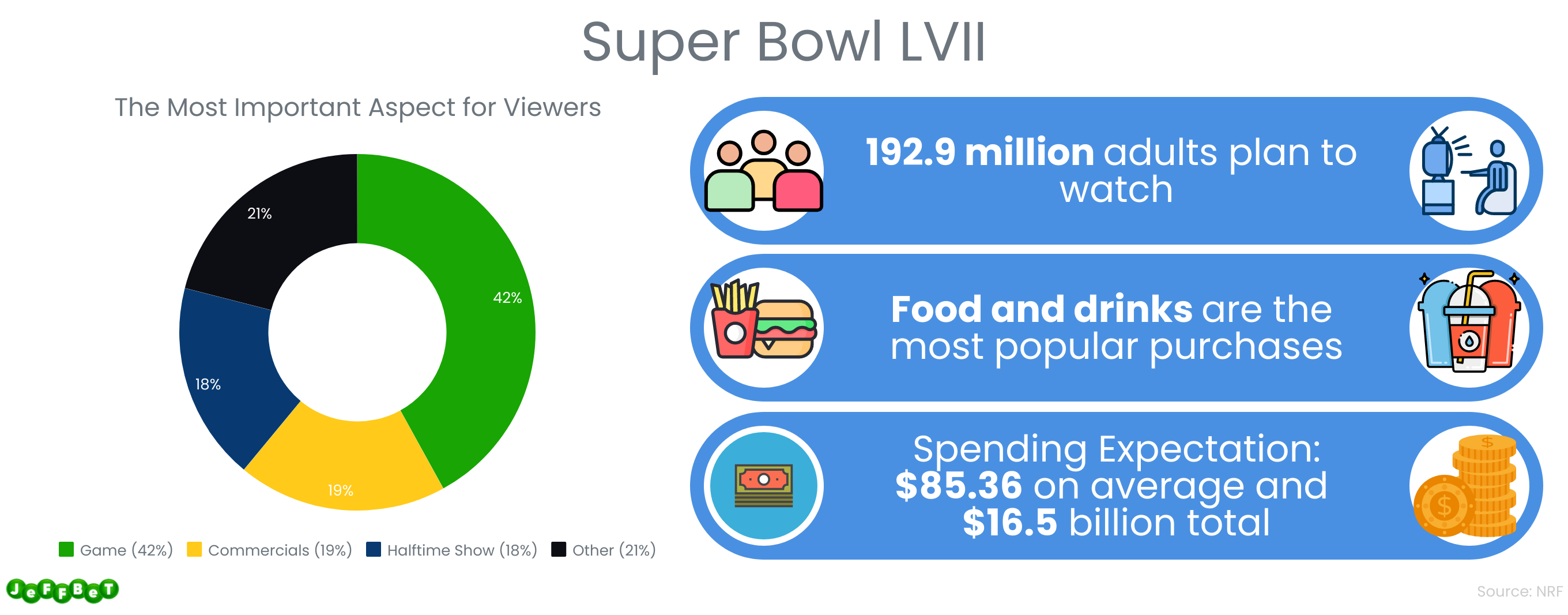
- 115.1 million: The number of viewers who tuned in for Super Bowl LVII, making it the most-watched Super Bowl in recent years, surpassing the previous record of 114.4 million set in 2015 for Super Bowl XLIX.
- 36 million: The lowest number of television viewers in Super Bowl history. It occurred in 1969 during the Super Bowl III, which is sometimes cited as one of the biggest upsets in the history of professional sports. The New York Jets and Baltimore Colts competed in this championship game.
- 125: The number of non-US nations and territories where ESPN broadcast Super Bowl LVII, including Australia, the Netherlands, Latin America, and the Caribbean.
- 7 million: The highest amount of streams for a Super Bowl game. This record was set at Super Bowl LVII this year.
- 346,000: The least amount of streaming ever for a Super Bowl game. This record was set for Super Bowl XLVI in 2012.
- 75%: Share of Super Bowl viewers between the ages of 18 and 34 in 2022.
Consumer Spending
Studying consumer spending habits during the Super Bowl provides a valuable perspective for understanding broader economic trends and gaining insights into the state of the retail industry. Beyond its status as a sporting event, the Super Bowl offers a unique opportunity to gauge customer sentiment that goes beyond the game itself. The economic impact of the Super Bowl resonates across various sectors, from food choices to clothing purchases, making it a significant economic phenomenon that extends well beyond the boundaries of the game itself.
- $16.5 billion: The amount that American consumers are predicted to spend in 2023 on Super Bowl-related items, an increase of $1.9 billion from 2022. This sum includes food and drink, clothing, and gaming-related products.
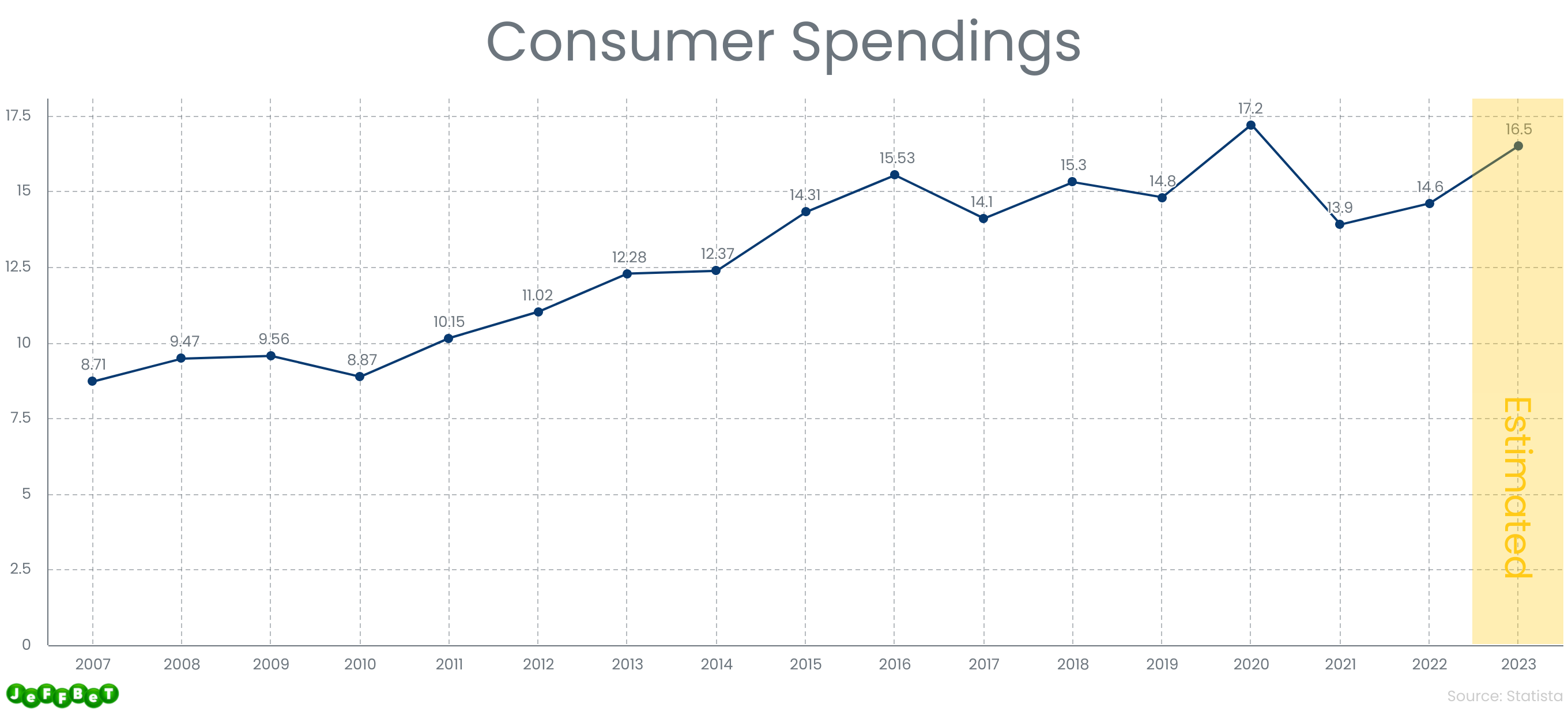
- $85.36: The average amount that those watching the Super Bowl in 2023 estimate to spend on food, drinks, apparel, decorations, and other products.
- $300: The amount that women consistently spend each year on NFL-related items. Men’s purchasing patterns were less consistent, with some spending more than $1000 annually and others none at all.
- 103.5 million: The estimated number of persons who planned to host or attend a Super Bowl party this year.
- 17.8 million: The number of individuals planning to watch the Super Bowl in a bar or restaurant.
- 79%: Food and drink will account for roughly 79% of purchases made during the 2023 Super Bowl games. Other purchases include team apparel (12%), TV purchases (10%), décor (7%), and furniture (7%).
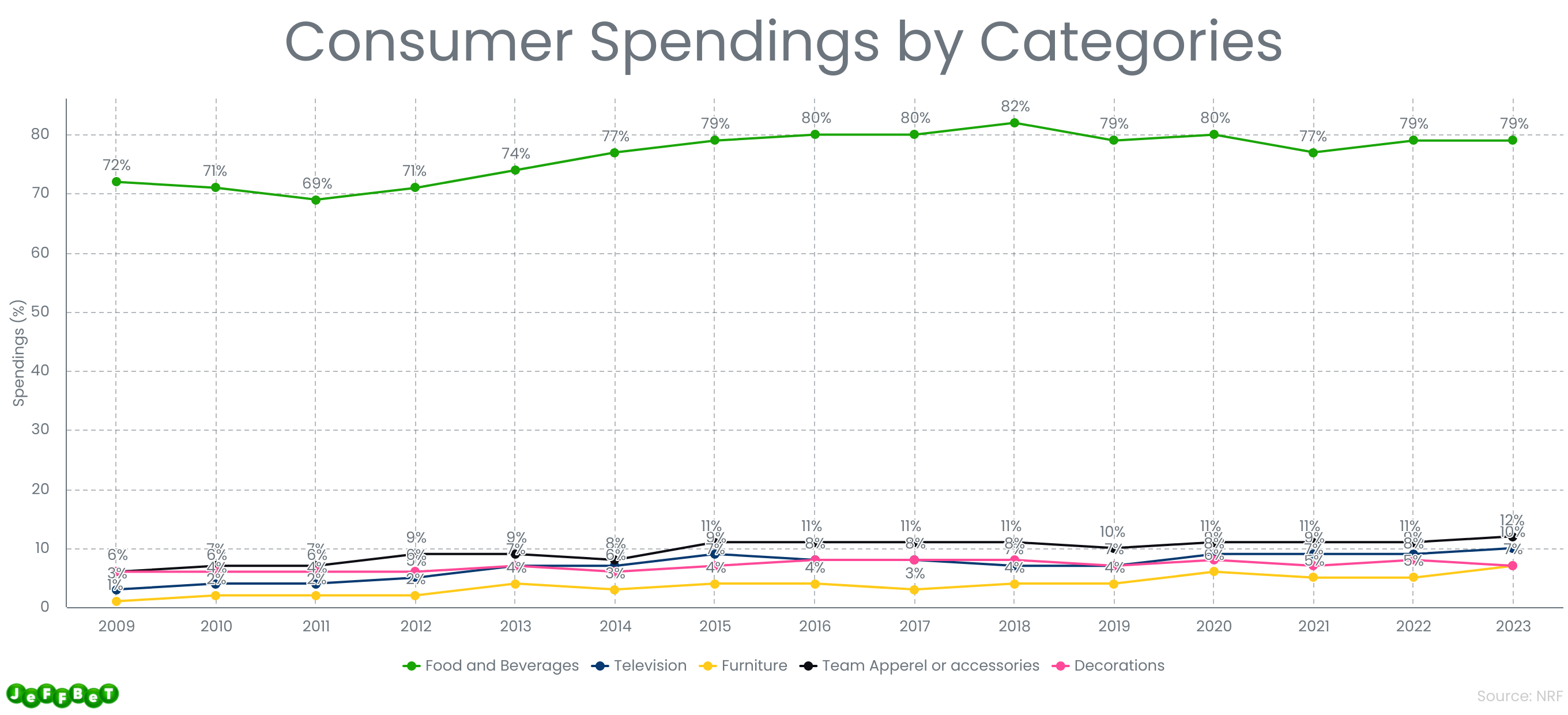
Food Consumption
The way people eat during the Super Bowl reflects a unique cultural tradition associated with the event. It stands as evidence of the Super Bowl’s multifaceted importance, going beyond just being a sports spectacle to becoming a beloved social and culinary tradition that promotes a sense of community and togetherness.
- 1.25 billion: The approximate quantity of chicken wings that Americans eat on Super Bowl Sunday.
- 14 billion: The amount of hamburgers grilled nationwide during Super Bowl Sunday.
- 325 million: Beer consumed in gallons during Super Bowl Sunday.
- 138 million: Guacamole eaten on Super Bowl Sunday, in pounds.
- 293,000 miles: The distance that every tortilla ate on Super Bowl Sunday would go if all of the chips were lined up.
Super Bowl Ads
Super Bowl advertisements are not just about expensive and highly sought-after ad space; they provide a rich source of insights into consumer behavior and the ever-changing media landscape. A thorough examination of the cost and effectiveness of these ads can reveal significant cultural shifts and preferences that reach far beyond the game itself, offering valuable insights into broader societal trends.
- $7 million: What a 30-second commercial during the Super Bowl cost advertisers on average in 2023.
- $37,500: The average cost advertisers paid for a 30-second commercial in 1967.
- $700 million: The total estimated value of all 80 to 100 Super Bowl commercials.
- $26 million: The amount spent on the most expensive Super Bowl ad ever to air. The commercial, which ran in 2022, was promoting Amazon’s cloud-based voice service Alexa. It lasted 130 seconds and was titled “Mind Reader,” starring Scarlett Johansson and Colin Jost.
- $500 million: The approximate amount of money made through advertising on one Super Bowl night.
- 100 million: The total number of YouTube users who saw the most-watched Super Bowl commercial as of 2023. It was called “Somewhere, Anywhere” for Booking.com and starred Melissa McCarthy.
- 641,000 hours: The amount of time people spent watching Super Bowl commercials on YouTube in 2019.
Host Cities and Stadiums
The Super Bowl experience is greatly shaped by the city that hosts it. The NFL’s careful selection of the host city not only reflects the league’s growth plans but also highlights areas where the sport has gained significant popularity. This choice serves as a clear indicator, mapping the geographical evolution and path of the Super Bowl, offering an illustrative story of its ever-changing journey.
- 11: The most Super Bowls that have been held in a single city. The city of Miami receives this honor.
- 1: The fewest instances in which one city has hosted the Super Bowl. Five cities, namely Tempe, Jacksonville, Arlington, Indianapolis, and New Jersey, share this distinction.
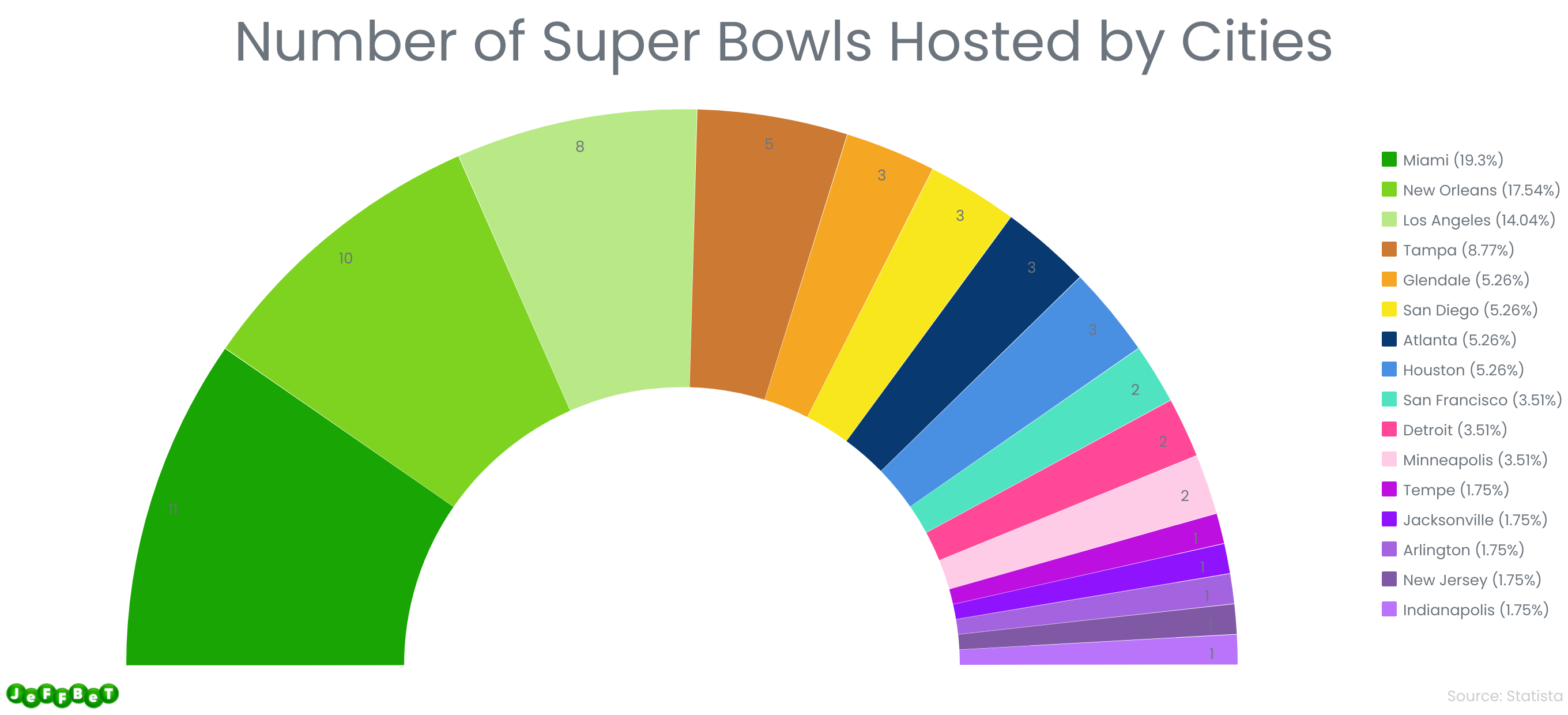
- 11: The most Super Bowls that have taken place in a single stadium. The most Super Bowls have been played at the Superdome in New Orleans, which has hosted the game 11 times.
- $5.5 billion: The cost of constructing the most expensive NFL stadium ever built. It is the SoFi Stadium in Inglewood, California.
- 82,500: The amount of spectators that can fit in the largest NFL stadium by capacity. It is MetLife Stadium located in East Rutherford, New Jersey.
- 61,500: The amount of people that can fit in the smallest NFL stadium by capacity. It is Soldier Field located in Chicago, Illinois.
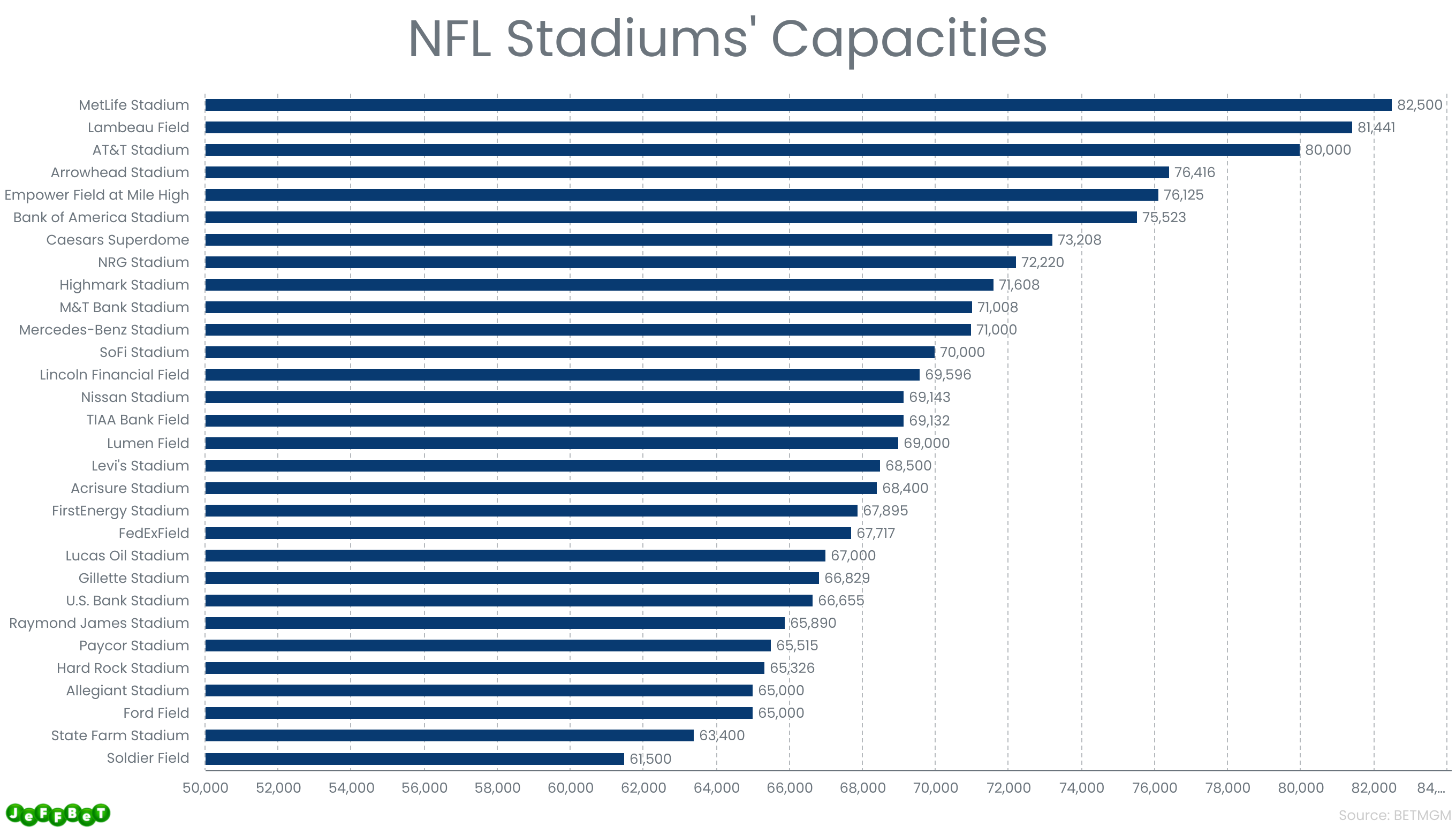
- 50°F: The minimum required temperature for a stadium to qualify to host a Super Bowl. Super Bowls cannot be held in stadiums with temperatures below 50°F unless they are totally enclosed by a dome or a retractable roof.
Internet Usage
In the modern digital era, including internet usage statistics on a Super Bowl page is essential. These statistics reflect the changing habits of the audience but also emphasize the scale of internet usage during the game.
- 60%: Percentage of spectators who used Verizon’s network while watching Super Bowl LVII.
- 47.8TB: How much data Verizon customers used inside and outside of State Farm Stadium during Super Bowl LVII.
- 21TB: The volume of data consumed on AT&T networks during Super Bowl LVII.
- 633MB: The most data consumed per connected device in Super Bowl history. It happened during Super Bowl LVII, when each fan utilized around 633MB of data.
- 828%: The highest growth over baseline percentage the Eagles’ website reached around time of kickoff during Super Bowl LVII.
- 514%: Highest growth above baseline the Chiefs’ website peaked around the third touchdown during Super Bowl LVII.
NFL Teams
NFL teams are at the core of what makes the Super Bowl special. This event goes beyond just a game between two teams; it represents the culmination of an entire NFL season, proudly displaying the highest level of American football excellence and featuring the league’s best teams.
- $5.11 billion: The average valuation of all 32 NFL franchises. Compared to last year, this was an increase of 14%.
- $9 billion: The value of the Dallas Cowboys, who, as of 2023, are the most valued NFL team.
- $3.5 billion: The value of the Cincinnati Bengals, who, as of 2023, are the NFL’s least valuable team.
- 13: The most titles that a single team has garnered. This major achievement is reached by the Green Bay Packers.
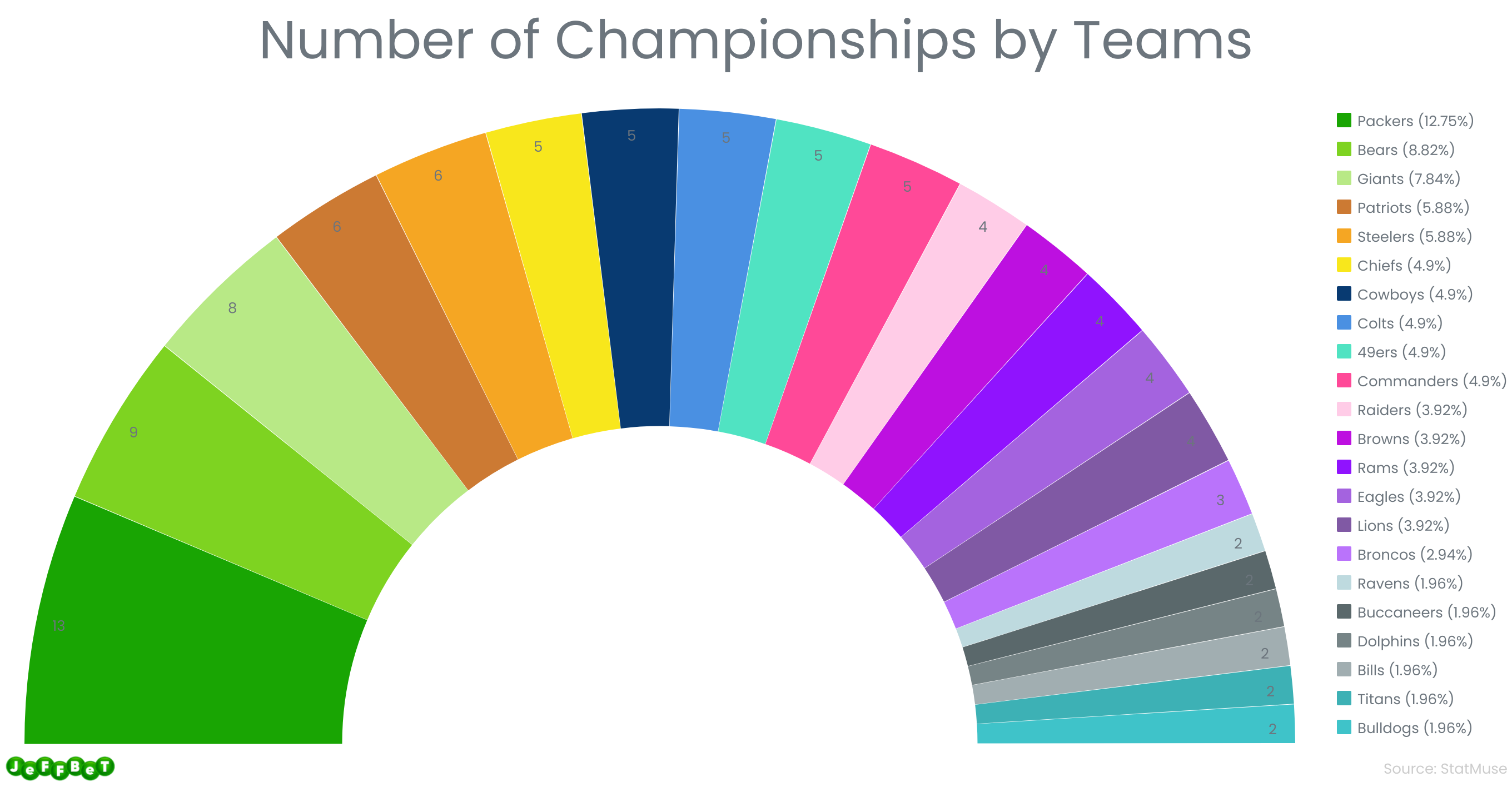
- 11: The highest number of times a team has made the Super Bowl as of 2023. The New England Patriots have achieved this milestone.
In-Game Statistics
In-game statistics provide a thorough and objective view of the game’s dynamics and player performance. They offer a numerical framework for evaluating performances over different periods, allowing us to recognize and admire individual player accomplishments.
- 65 yards: The longest punt return in Super Bowl history. Kadarius Toney accomplished this feat for the Chiefs against the Eagles in Super Bowl LVII.
- 22 touchdowns: The most career postseason touchdowns in NFL history. Jerry Rice set this record.
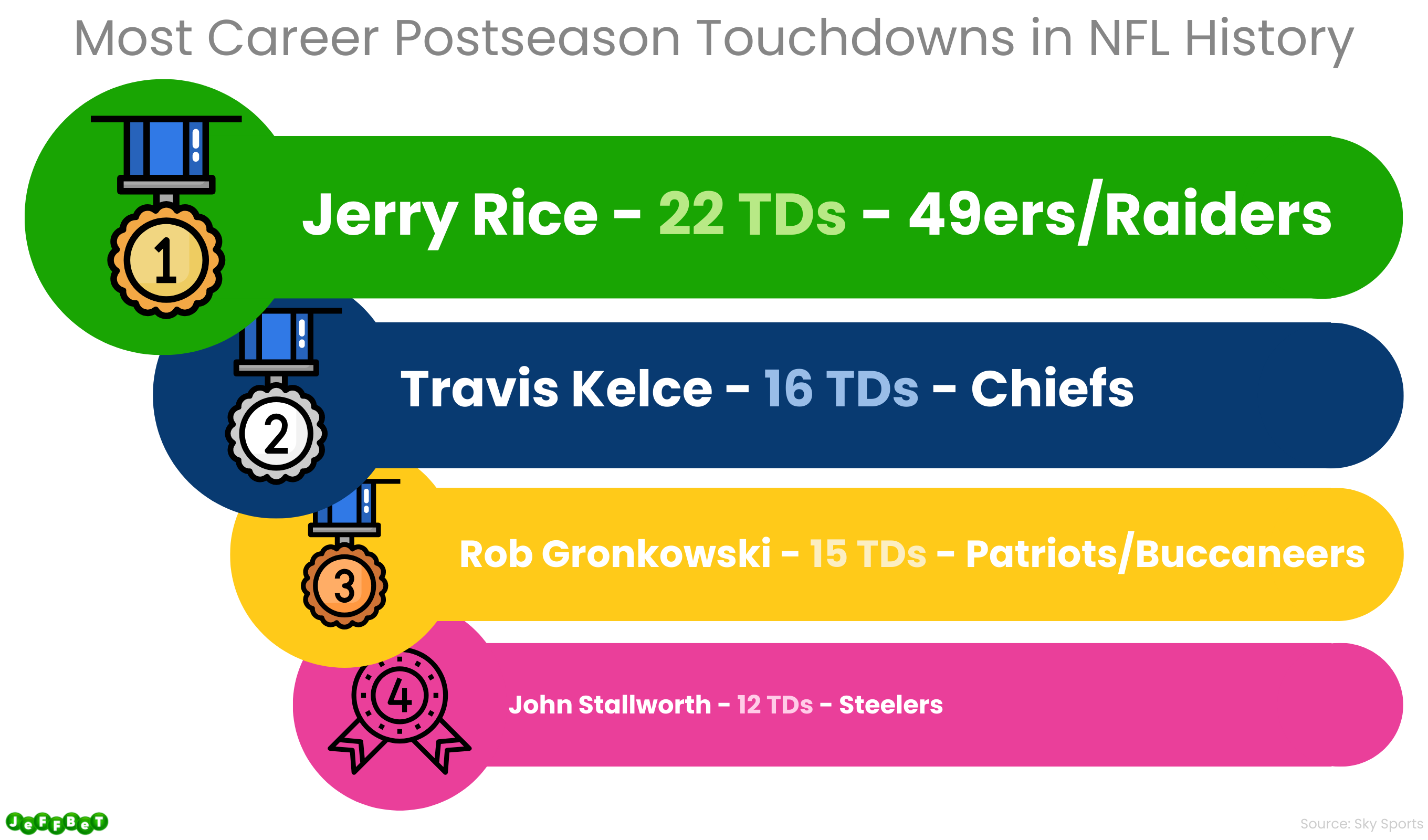
- 70 yards: The most rushing yards ever accumulated by a quarterback in a Super Bowl. Jalen Hurts set this record for the Eagles during Super Bowl LVII.
- 29.2 points: The highest number of points that a team has ever averaged per game as of 2022. The Kansas City Chiefs achieved this feat.
- 16.9 points: The lowest point total that a team has ever averaged per game as of 2022. The Denver Broncos achieved this milestone.
Super Bowl Halftime Show
The Super Bowl halftime show has transformed into a massive spectacle, captivating millions of viewers and frequently sparking its own trending discussions and headlines. To measure its immense popularity and cultural importance, one can look at metrics like viewership statistics, performance data, and social media engagement. These metrics stand as proof of the Super Bowl’s entertainment appeal and its significant influence on the broader cultural scene.
- 121.017 million: The total count of people who viewed the Super Bowl LVII performance by Rihanna. This makes the halftime show this year the most watched in recent memory.
- 133 million: The number of people who watched the Super Bowl halftime show with the most viewers ever. Michael Jackson performed this halftime performance in 1993 at the Super Bowl XXVII.
- $17 million: The price tag for the most expensive halftime performance in Super Bowl history, headlined by The Weeknd in 2021 for Super Bowl LV.
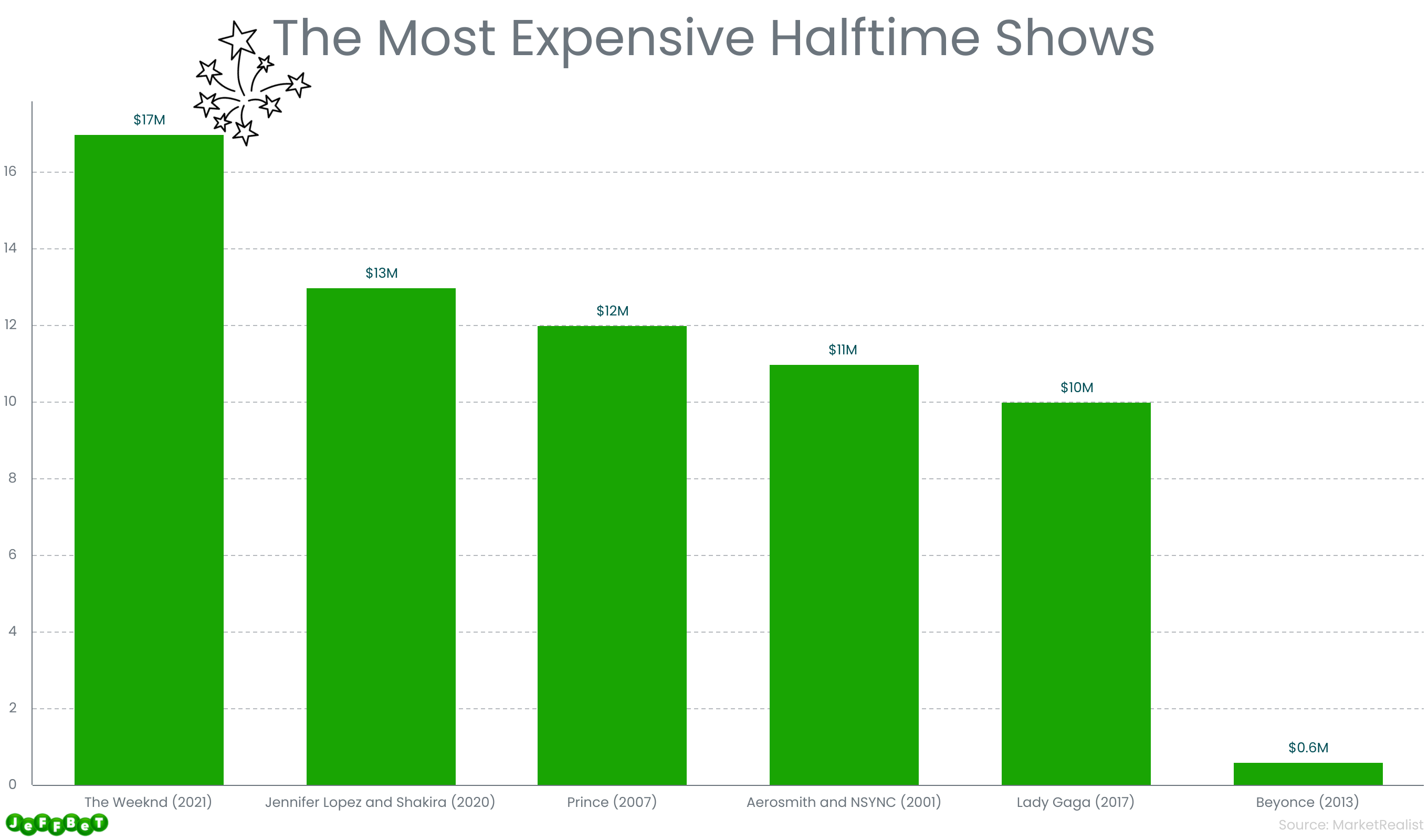
- 14.2 million: The number of interactions there were on social media between February 10 and February 14 during the Super Bowl LVII halftime performance.
- 12 to 14 minutes: The typical length of a Super Bowl halftime performance.
- 14 minutes: The longest performance in Super Bowl history, featuring Justin Timberlake for Super Bowl LII in 2018.
Social Media
In today’s digital era, social media platforms have become essential in influencing how people interact with and fully engage in the Super Bowl experience. They offer a dynamic avenue for immediate updates, live commentary, and a platform for fans to express their feelings. Analyzing social media statistics provides insights into the game’s impact on society, highlighting its role as a cultural touchstone.
- 323,822: The number of engagements Apple Music received, which was the platform with the most engagements overall for Super Bowl LVII.
- 82.7%: Percent of the increase in subscribers the Eagles had for their YouTube channel during Super Bowl LVII.
- 44.4%: Percent of the increase in subscribers the Chiefs had on their YouTube channel during Super Bowl LVII.
- 312,000: The number of times during Super Bowl LVII that Super Bowl advertising was discussed on X (Twitter), which works out to 1,300 mentions per minute.
- 39,000: The most registered mentions a brand received during Super Bowl LVII, reached by the brand Tubi.
- 13,800: The number of times the most popular hashtag, “#UltraClub” for the brand Michelob ULTRA, was mentioned during Super Bowl LVII.
- 14,600: The number of times the most talked-about celebrity was mentioned during Super Bowl LVII. The actor Ben Affleck, who starred in a Dunkin’ Donuts commercial, garnered the most mentions.
Super Bowl Revenue
The Super Bowl’s revenue comes from a wide range of sources, including ticket sales, lucrative sponsorships, advertising investments, retail sales, and the significant economic impact it has on the host city. These various sources of income highlight the event’s enormous financial significance, influencing the sports industry and creating a substantial economic ripple effect in the host communities.
- $485 million: The amount of money made through advertising at the 2021 Super Bowl.
- $719 million:The economic impact of Super Bowl XLIX on Arizona in 2015.
- $4.7 billion: The amount predicted to be bet on Super Bowl LVII this year.
- $100 million: The amount that the NFL expects to make this year from sales of licensed Super Bowl items.
- $600 million: The economic impact of Super Bowl LVII on the Arizona economy this year.
- $167: How much money an average spectator spends inside the arena.
- $4.3 billion: A rough estimate of the bets placed on Super Bowl LVI in 2022.
- $295.2 million: The amount that non-residents spent while Indianapolis hosted the Super Bowl in 2012.
- $9,000: The average secondary market ticket price for Super Bowl LVII, the second-most expensive NFL championship game in history.
- $3,219: The least expensive Super Bowl LVII ticket price.
- $43,050: The cost of a front-row Super Bowl seat.
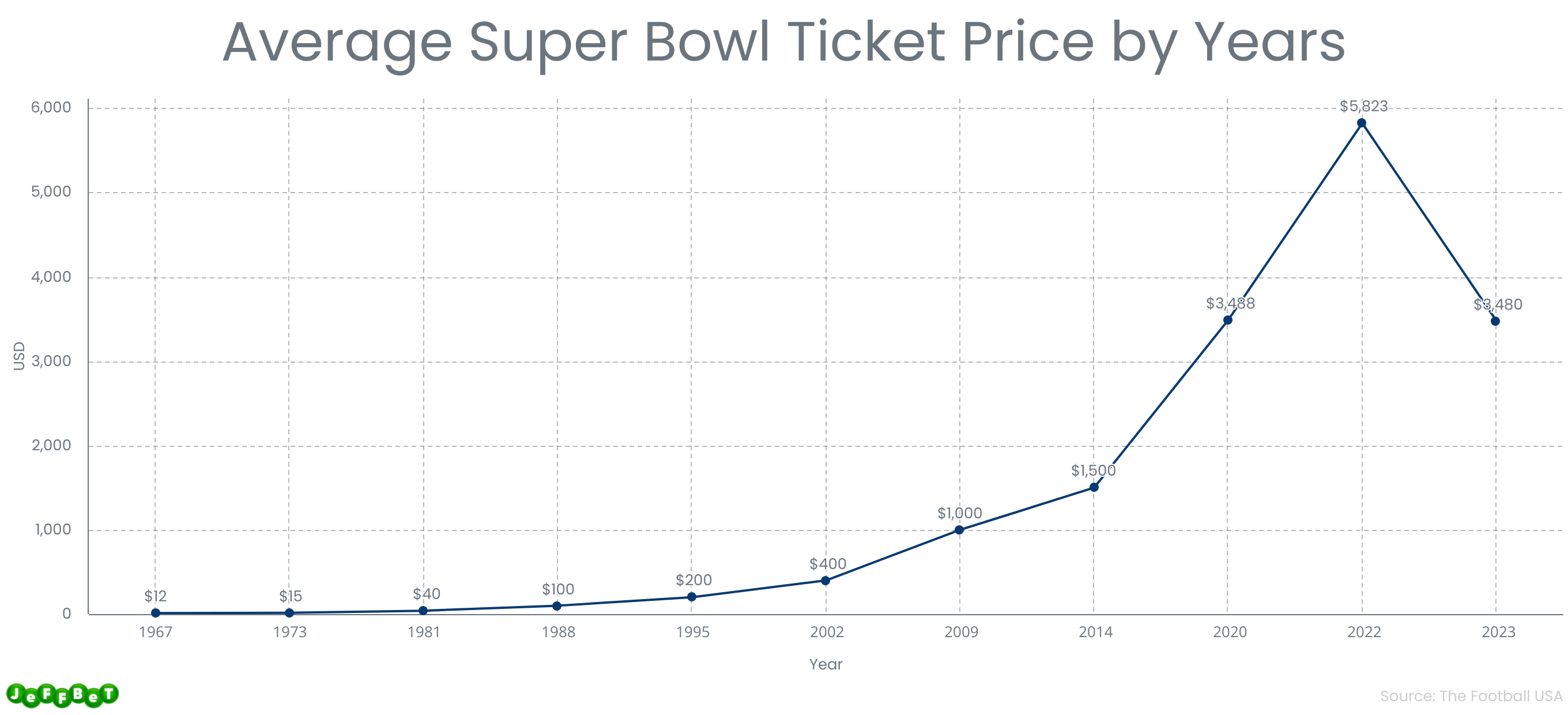
Super Bowl Stats FAQs
Sources:
- history.com
- life.com
- medium.com
- today.com
- britannica.com
- en.as.com
- nfl.com
- profootballnetwork.com
- statista.com
- foxsports.com
- espn.com
- statmuse.com
- sportingnews.com
- summitwealthgroup.com
- forbes.com
- thefootballusa.com
- smallbusiness.chron.com
- brandwatch.com
- marketingdive.com
- analyticsblog.blinkfire.com
- semrush.com
- si.com
- quintly.com
- marketrealist.com
- hollywoodreporter.com
- billboard.com
- skysports.com
- blog.cloudflare.com
- extremenetworks.com
- wia.org
- verizon.com
- fox21news.com
- sports.betmgm.com
- constructiondisputes.com
- profootballhof.com
- variety.com
- nbcdfw.com
- tradingpedia.com
- lxahub.com
- bleacherreport.com
- sportslens.com
- nrf.com
- premiofoods.com
- martecgroup.com
- pro.morningconsult.com
- sportsmediawatch.com
- theverge.com
- espnpressroom.com
- boardroom.tv
